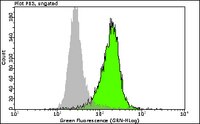FCMAB108A4 Sigma-AldrichAnti-phospho-SMC1 (Ser957) Antibody, clone 5D11G5 Alexa Fluor® 488
This Anti-phospho-SMC1 (Ser957) Antibody, clone 5D11G5 Alexa Fluor 488 is validated for use in WB, FC for the detection of phospho-SMC1 (Ser957).
More>> This Anti-phospho-SMC1 (Ser957) Antibody, clone 5D11G5 Alexa Fluor 488 is validated for use in WB, FC for the detection of phospho-SMC1 (Ser957). Less<<Recommended Products
Overview
| Replacement Information |
|---|
Key Specifications Table
| Species Reactivity | Key Applications | Host | Format | Antibody Type |
|---|---|---|---|---|
| H, Xn, B | WB, FC | M | AlexaFluor®488 | Monoclonal Antibody |
| References |
|---|
| Product Information | |
|---|---|
| Format | AlexaFluor®488 |
| Control |
|
| Presentation | Purified mouse monoclonal IgG1 conjugated to Alexa Flour® 488 in PBS with 0.1% sodium azide and 15 mg/mL BSA. |
| Quality Level | MQ100 |
| Physicochemical Information |
|---|
| Dimensions |
|---|
| Materials Information |
|---|
| Toxicological Information |
|---|
| Safety Information according to GHS |
|---|
| Safety Information |
|---|
| Storage and Shipping Information | |
|---|---|
| Storage Conditions | Maintain refrigerated at 2-8°C in undiluted aliquots for up to 6 months from date of receipt. Protect from light. |
| Packaging Information | |
|---|---|
| Material Size | 100 tests |
| Transport Information |
|---|
| Supplemental Information |
|---|
| Specifications |
|---|
| Global Trade Item Number | |
|---|---|
| Catalog Number | GTIN |
| FCMAB108A4 | 04053252472855 |
Documentation
Anti-phospho-SMC1 (Ser957) Antibody, clone 5D11G5 Alexa Fluor® 488 SDS
| Title |
|---|









